启发式搜索 ¶
约 2102 个字 240 行代码 8 张图片 预计阅读时间 11 分钟
启发函数(Heuristic Function
g(n) 描述了从起点到当前节点的耗散,h(n) 描述了从当前节点到终点的预估耗散
贪婪最佳优先搜索 ¶
A* 搜索 ¶
A * 搜索算法(英文:A*search algorithm,A * 读作 A-star
过程 ¶
定义起点 \(s\),终点 \(t\),从起点(初始状态)开始的距离函数 \(g(x)\),到终点(最终状态)的距离函数 \(h(x)\),\(h^{\ast}(x)\),以及每个点的估价函数
A * 算法每次从优先队列中取出一个 \(f\) 最小的元素,然后更新相邻的状态。
如果 \(h\leq h^*\)(不高估计到达目标的最低路径耗散值 ),则 A * 算法能找到最优解。
上述条件下,如果 \(h\) 满足三角形不等式,则 A * 算法不会将重复结点加入队列。
当 \(h=0\) 时,A * 算法变为 Dijkstra;当 \(h=0\) 并且边权为 \(1\) 时变为 BFS。
例题 ¶
八数码
题目大意:在 \(3\times 3\) 的棋盘上,摆有八个棋子,每个棋子上标有 \(1\) 至 \(8\) 的某一数字。棋盘中留有一个空格,空格用 \(0\) 来表示。空格周围的棋子可以移到空格中,这样原来的位置就会变成空格。给出一种初始布局和目标布局(为了使题目简单,设目标状态如下
123
804
765
解题思路
\(h\) 函数可以定义为,不在应该在的位置的棋子个数。
容易发现 \(h\) 满足以上两个性质,此题可以使用 A * 算法求解。
爬山法 ¶
不断与邻居节点的值比较,并选择值更高的节点作为下一个迭代的节点
- 算法不会考虑与当前状态不相邻的状态,不维护搜索树
Step 1: 评估当前的初始状态。如果是目标状态,则返回并退出。
Step 2: 如果当前状态不是目标状态,则循环运行,直到找到解决方案或没有其他操作可比较。
Step 3: 选择一个新状态进行比较。
Step 4: 评估新状态:
- 如果是目标状态,即最高峰,则退出。
- 如果它比当前状态好,则使其成为新的当前状态。
- 如果不是比当前状态更好,请转到步骤2。
存在局部最优的问题¶
- 解决方法:每次不一定选择邻域内最优的点,而是依据一定概率从邻域内选择一个点:指标函数优的点被选中的概率大,指标函数差的点被选中的概率小
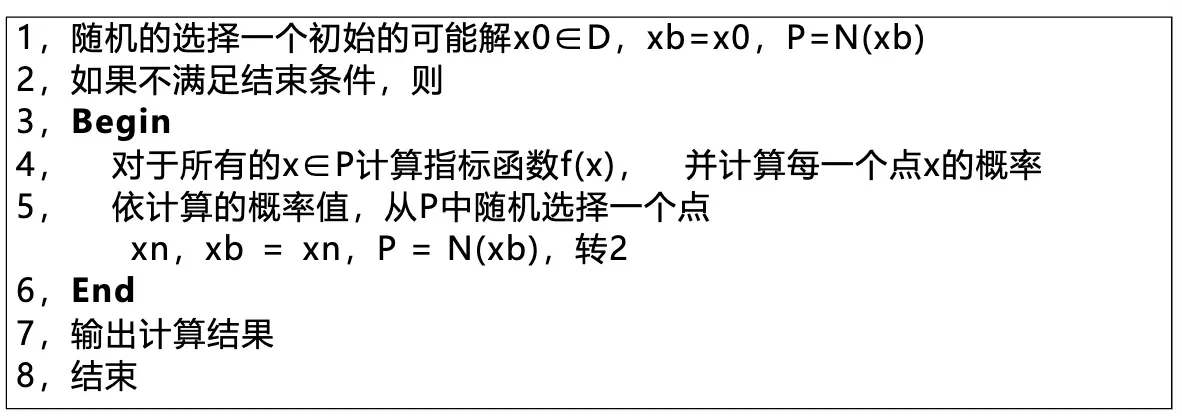
爬山算法的优势在于当正解的写法你并不了解(常见于毒瘤计算几何和毒瘤数学题
存在步长选取的问题¶
- 解决方法:变步长
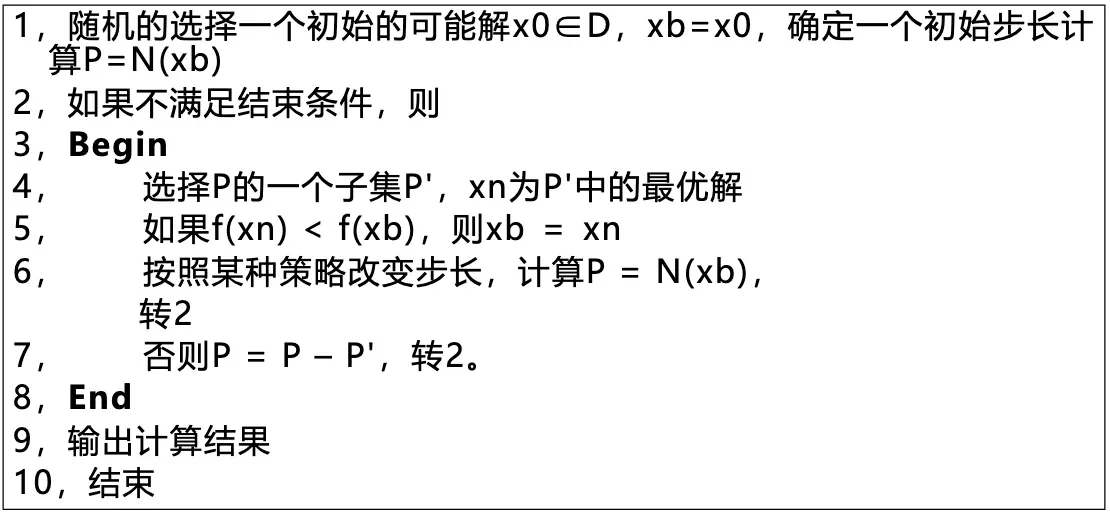
爬山算法一般会引入温度参数(类似模拟退火
兔子逐渐变得清醒的过程就是降温过程,即温度参数在爬山的时候会不断减小。
关于降温:降温参数是略小于 1 的常数,一般在 [0.985, 0.999] 中选取。
存在起始点的问题¶
- 解决方法:随机生成一些初始点,从每个初始点出发进行搜索,找到各自的最优解。再从这些最优解中选择一个最好的结果作为最终结果
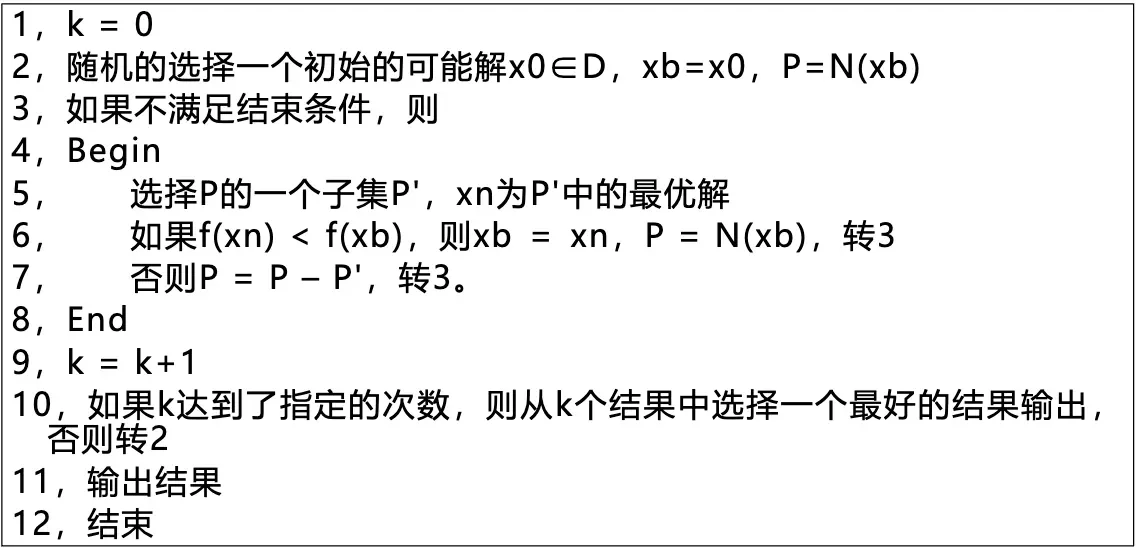
模拟退火法 | Simulated Annealing ¶
如果新状态的解更优则修改答案,否则以一定概率接受新状态
- 初始解: 随机选择一个初始解,并设置初始温度。
- 迭代过程: - 在当前解的邻域中随机选择一个新的解。 - 计算新解的能量(或成本)与当前解的能量之差\(\Delta E\)。 如果新解的能量更低(\(\Delta E<0\)),则接受该新解;如果新解的能量更高,则以一定概率接受该解
- 退火: 逐步降低温度,通常使用冷却调度(如指数冷却)来控制温度的下降。
- 终止条件: 算法在达到预设的迭代次数或温度低于某一阈值时终止。
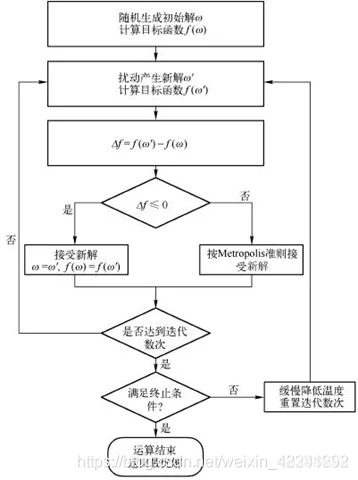
Metropolis 准则 ¶
- \(P(\text{accept})\) 是接受新解的概率。
- 新解如果更优就直接接受,新解如果没有更优就以一定概率接受。
- \(T\) 是当前的温度。
退火参数 ¶
一开始初始温度较高,使的所有转移状态都被接受。初始温度越高,获得高质量的解的概率越大,耗费的时间越长。
随着迭代次数增加,温度逐渐降低(使用类似指数衰减函数
如果温度下降到终止温度或者达到用户设定的阈值,则退火完成。
- \(T(n) = \lambda T(n-1)\), \(\lambda\) 是降温系数 , 一般取值在 0.8-0.99 之间。
- \(T(n ) =\frac{T_0}{log(1+t)}\)
- \(T(n) = \frac{T_0}{1+t}\)
分析 ¶

随着温度的降低,跳跃越来越不随机,最优解也越来越稳定
例子 ¶
其最优状态和最优值为
import math
from random import random
import matplotlib.pyplot as plt
def func(x, y): #x为公式里的x1,y为公式里面的x2
res= 4*x**2-2.1*x**4+x**6/3+x*y-4*y**2+4*y**4
return res
class SA:
def __init__(self, func, iter=100, T0=100, Tf=0.01, alpha=0.99):
self.func = func
self.iter = iter # 内循环迭代次数,即为 L=100
self.alpha = alpha # 降温系数,alpha=0.99
self.T0 = T0 # 初始温度 T0 为 100
self.Tf = Tf # 温度终值 Tf 为 0.01
self.T = T0 # 当前温度
self.x = [random() * 11 -5 for i in range(iter)] #x in [-5,5],随机生成100个x的值
self.y = [random() * 11 -5 for i in range(iter)] #y in [-5,5],随机生成100个y的值
self.most_best =[] # 最优解
self.history = {'f': [], 'T': []} # 记录最优解和温度
def generate_new(self, x, y): #扰动产生新解的过程
while True:
x_new = x + self.T * (random() - random())
y_new = y + self.T * (random() - random())
if (-5 <= x_new <= 5) & (-5 <= y_new <= 5):
break # 重复得到新解,直到产生的新解满足约束条件
return x_new, y_new
def Metrospolis(self, f, f_new): #Metropolis准则
if f_new <= f:
return 1
else:
p = math.exp((f - f_new) / self.T)
if random() < p:
return 1
else:
return 0
def best(self): #获取最优目标函数值
f_list = [] #f_list数组保存每次迭代之后的值
for i in range(self.iter):
f = self.func(self.x[i], self.y[i])
f_list.append(f)
f_best = min(f_list)
idx = f_list.index(f_best)
return f_best, idx #f_best,idx分别为在该温度下,迭代L次之后目标函数的最优解和最优解的下标
def run(self):
count = 0
while self.T > self.Tf: # 外循环迭代,当前温度小于终止温度的阈值
for i in range(self.iter): # 内循环迭代 指定次数
f = self.func(self.x[i], self.y[i]) #f为迭代一次后的值
x_new, y_new = self.generate_new(self.x[i], self.y[i]) #产生新解
f_new = self.func(x_new, y_new) #产生新值
if self.Metrospolis(f, f_new): #判断是否接受新值
self.x[i] = x_new #如果接受新值,则把新值的x,y存入x数组和y数组
self.y[i] = y_new
# 迭代L次记录在该温度下最优解
ft, _ = self.best()
self.history['f'].append(ft)
self.history['T'].append(self.T)
self.T = self.T * self.alpha # 温度按照一定的比例下降(冷却)
count += 1
# 得到最优解
f_best, idx = self.best()
print(f"F={f_best}, x={self.x[idx]}, y={self.y[idx]}")
sa = SA(func)
sa.run()
plt.plot(sa.history['T'], sa.history['f'])
plt.title('SA')
plt.xlabel('T')
plt.ylabel('f')
plt.gca().invert_xaxis()
plt.show()
random() 这个函数取 0 到 1 之间的小数 如果你要取0-10之间的整数(包括0和10)就写成 (int)random()*11就可以了,11乘以零点多的数最大是10点多,最小是0点多 该实例中x1和x2的绝对值不超过5(包含整数5和-5),(random() * 11 -5)的结果是-6到6之间的任意值(不包括-6和6) (random() * 10 -5)的结果是-5到5之间的任意值(不包括-5和5),所有先乘以11,取-6到6之间的值,产生新解过程中,用一个if条件语句把-5到5之间(包括整数5和-5)的筛选出来。
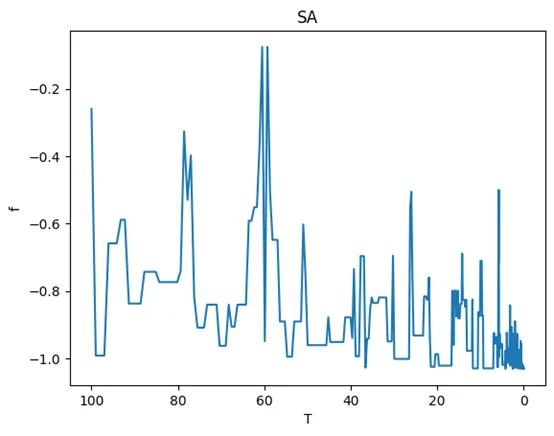
遗传算法 ¶
蚂蚁在路径上释放信息素。后到的蚂蚁沿信息素浓度高的路径行走。 在所有可能的路径中,由于往返最短路径花的时间少,通过频率高,所以信息素浓度高。这又会吸引更多蚂蚁走这条路径,形成正反馈。
每只蚂蚁只关心局部的信息
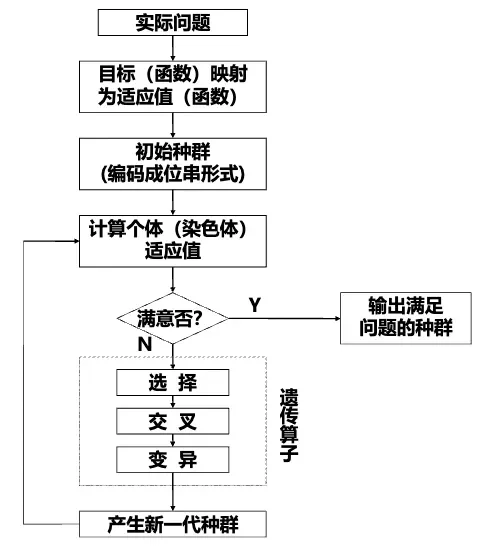
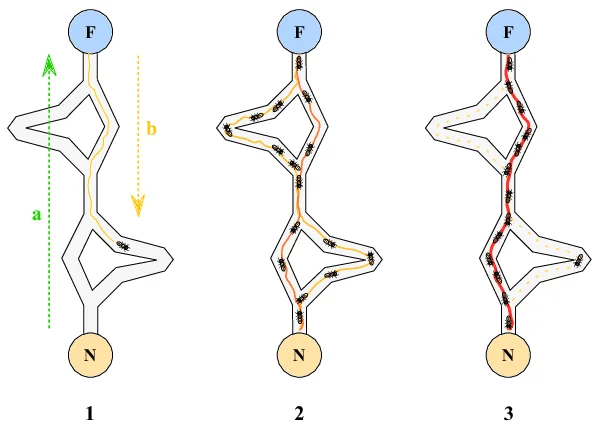
- 编码和初始群体生成
- 群体评价
- 个体选择
- 交换和变异
与传统优化算法的不同:
- 并非直接作用在参变量集上而是利用参变量集的某种编码
- 不是从单个点,而是从一个点的群体开始搜索
- 利用适应值信息,无须导数或其他辅助信息
- 利用概率转移规则,而非确定性规则
优越性:
- 不易陷入局部最优
- 算法具有并行性,适合大规模并行计算机
常见问题 ¶
八皇后问题 ¶
TSP | 旅行商问题 ¶
例子——可拆分的 TSP
class Ant:
def __init__(self, num_customers, num_vehicles, capacity, demands):
self.num_customers = num_customers
self.num_vehicles = num_vehicles
self.capacity = capacity
self.routes = [[] for _ in range(num_vehicles)]
self.route_num = 1
self.route = [[] for _ in range(num_vehicles)]
self.loads = [0] * num_vehicles
self.demands = demands
self.visited = set()
def add_route(self):
self.route.append([])
def add_customer_to_route(self, route_num, customer):
while len(self.route) <= route_num:
self.add_route()
self.route[route_num].append(customer)
def visit_customer(self, vehicle, customer):
self.routes[vehicle].append(customer)
self.add_customer_to_route(self.route_num, customer)
demand = self.demands[customer] # 调整索引以适应需求数组
if (self.capacity - self.loads[vehicle] >= demand): # 如果车够空,全都装掉
self.loads[vehicle] += demand
self.demands[customer] = 0
else: # 如果不空,装满为止
self.demands[customer] -= (self.capacity - self.loads[vehicle])
self.loads[vehicle] = self.capacity
self.visited.add(customer)
def can_visit(self, vehicle, customer):
return (self.loads[vehicle] < self.capacity)
def return_to_depot(self, vehicle):
self.routes[vehicle].append(0)
self.add_customer_to_route(self.route_num, 0)
self.route_num += 1
self.loads[vehicle] = 0
class ACO:
def __init__(self, num_customers, num_vehicles, capacity, demands, distance_matrix, num_ants, num_iterations,
alpha=1, beta=5, evaporation_rate=0.3):
self.num_customers = num_customers
self.num_vehicles = num_vehicles
self.capacity = capacity
self.demands = demands
self.distance_matrix = distance_matrix
self.num_ants = num_ants
self.num_iterations = num_iterations
self.alpha = alpha
self.beta = beta
self.evaporation_rate = evaporation_rate
self.pheromone_matrix = np.ones((num_customers + 1, num_customers + 1))
self.best_routes = None
self.best_distance = 10000000
self.dis = []
def plot_best_distances(self): # 绘制收敛曲线
plt.plot(range(1, self.num_iterations + 1), self.dis)
plt.xlabel('Iteration')
plt.ylabel('Best Distance')
plt.title('Best Distance vs Iteration')
plt.grid(True)
plt.savefig('../result/three_eva_rate_aco_convergence.png')
plt.show()
def run(self):
for iteration in range(self.num_iterations):
# print(iteration)
ants = [Ant(self.num_customers, self.num_vehicles, self.capacity, copy.deepcopy(demands)) for _ in
range(self.num_ants)]
for ant in ants:
self.construct_solution(ant)
distance = self.calculate_total_distance(ant.routes)
if distance < self.best_distance:
self.best_distance = distance
self.best_routes = ant.routes
self.dis.append(self.best_distance)
self.update_pheromones(ants)
# print(f'Iteration {iteration + 1}/{self.num_iterations}, Best distance: {self.best_distance}')
return self.best_routes, self.best_distance
def construct_solution(self, ant):
for vehicle in range(self.num_vehicles):
current_customer = 0 # 从仓库开始
# print(ant.demands.values())
while any(idemand > 0 for idemand in ant.demands.values()):
# print(ant.demands.values())
next_customer = self.select_next_customer(ant, current_customer)
# print(current_customer,next_customer)
if next_customer is not None:
if ant.can_visit(vehicle, next_customer):
ant.visit_customer(vehicle, next_customer)
current_customer = next_customer
else: # 返回仓库卸货
ant.return_to_depot(vehicle)
current_customer = 0 # 返回仓库
else:
ant.return_to_depot(vehicle) # 确保车辆最终返回仓库
current_customer = 0
# print(ant.routes)
# break # 没有更多客户可以访问
def select_next_customer(self, ant, current_customer):
probabilities = []
for customer in range(0, self.num_customers + 1):
if ant.demands.get(customer, 0) == 0 or customer == current_customer:
continue
pheromone = self.pheromone_matrix[current_customer][customer] ** self.alpha
visibility = (1.0 / self.distance_matrix[current_customer][customer]) ** self.beta
probabilities.append((pheromone * visibility, customer))
if not probabilities:
return None
total_prob = sum(prob for prob, customer in probabilities)
if total_prob == 0:
return None
probabilities = [(prob / total_prob, customer) for prob, customer in probabilities]
rand = np.random.random()
cumulative_prob = 0.0
for prob, customer in probabilities:
cumulative_prob += prob
if rand <= cumulative_prob:
return customer
return None
def calculate_total_distance(self, routes): # 根据路径列表计算最短路径的长度
total_distance = 0
for route in routes:
if route:
distance = 0
# print("route", route)
for i in range(len(route) - 1):
distance += self.distance_matrix[route[i]][route[i + 1]]
distance += self.distance_matrix[route[-1]][0] # 返回仓库
distance += self.distance_matrix[0][route[0]]
total_distance += distance
return total_distance
def update_pheromones(self, ants):
self.pheromone_matrix *= (1 - self.evaporation_rate)
for ant in ants:
distance = self.calculate_total_distance(ant.routes)
for route in ant.routes:
for i in range(len(route) - 1):
self.pheromone_matrix[route[i]][route[i + 1]] += 1.0 / distance
if route:
self.pheromone_matrix[route[-1]][route[0]] += 1.0 / distance # 返回仓库